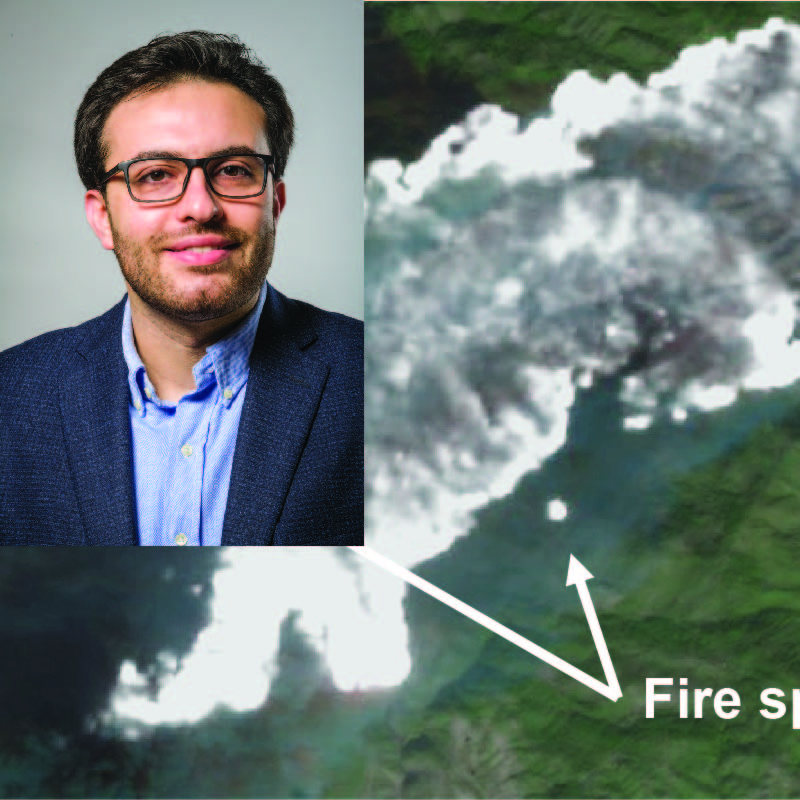News Story
FPE Professors Highlight Work on Fire Resilence
University of Maryland Department of Fire Protection Engineering (FPE) faculty members presented the department’s efforts to advance fire resilience in the face of natural and man-made disasters at Mpact, the A. James Clark School of Engineering’s weeklong showcase of innovations that will benefit millions of people around the world.
FPE Professor and Chair Jim Milke hosted the Multi-Hazard Resilience session, which included keynotes by Stephen Cauffman, the National Institute of Standards and Technology’s [NIST] Lead for Disaster Resilience, and NIST’s Chief of Fire Research, Anthony Hamins. Professors Andre Marshall and Arnaud Trouvé represented FPE at the event. Department of Civil and Environmental Engineering professors Bilal Ayyub, Yunfeng Zhang, and Elise Miller-Hooks presented their work on structural safety monitoring and transportation resilience. The session also included poster presentations and Q&A with the speakers.
All of the session’s presentations are available at the Mpact web site, and the entire session can be viewed online.
Jim Milke: Opening Remarks
Milke introduced the morning’s theme with a sobering fact: natural and man-made disasters have quadrupled since 1953. One of his personal concerns, he said, was that as these events become “common,” only the most extreme of them will receive media attention, while “modest” disasters, which nonetheless have real consequences and require recovery, will be overlooked.
“If we’re to respond to these increasingly common events, including wildfires, earthquakes, hurricanes, floods, severe storms, [and urban] fires…we must develop innovative solutions,” he told the audience.
Anthony Hammins: “Reducing the Impact of Fire in Buildings and Communities”
Hammins delivered the session’s first keynote address, which described NIST’s role in promoting fire resilience. NIST defines resilience as the ability to prepare, adapt, withstand and recover from deliberate attacks, accidents or naturally occurring threats or incidents. This includes fire, which, he explained, is the cause of 94% of disaster-related fatalities each year. NIST is working on fire prevention, protection and response by studying the natural, material, cultural and socioeconomic factors that influence where fires are more likely to occur, how they are fueled and how they spread. Hammins discussed a future of “smart firefighting” in which engineering innovation leads to integrated systems, materials, and tools that reduce human and capital losses.
Stephen Cauffman: “Community Disaster Resilience”
Cauffman presented NIST’s work in disaster resilience at the community scale. Our current approach to response and rebuilding after any kind of disaster, he told the audience, is inefficient and impractical, and doesn't account for interconnected infrastructure and social institutions, or rebuilding to higher standards. His team is developing a disaster resilience framework, including a standards panel, model guidelines, and a community resilience assessment tool that identifies physical and social interdependencies among systems. The goal, he said, is to help communities identify and restore critical and social services as quickly as possible by anticipating their needs before disaster strikes.
Arnaud Trouvé and Andre Marshall: “The Future of Fire Resilience ”
FPE professors Arnaud Trouvé and Andre Marshall delivered a joint presentation highlighting the department’s contributions to the field of resilience. Trouvé described how he and his collaborators develop predictive, “ensemble” simulations by integrating data collected from a variety of systems already in use. This includes weather and climate monitoring, air- and spaceborne fire front observations, and data acquisition using middle infrared imaging. Trouvé also highlighted the work of Assistant Professor Michael Gollner, who studies wildland–urban interface fire resilience. His work includes examining how structural materials react to firebrands, thermal radiation, and direct flame contact, and using that information to suggest adjustments to building codes and community planning that can mitigate damage and loss of life.
Marshall discussed his efforts to combine sensor-rich building environments and cyber/physical systems that shift fire detection objectives from mere notification to realtime information delivery used to guide response. These emerging systems allow firefighters to learn more about temperature, fire size, and the height of the smoke layer before they ever enter a building, and may even warn of impending structural failure. Marshall also discussed his group’s virtual framework for analyzing fire suppression systems. Finally, he described Assistant Professor Stanislav Stoliarov’s work in establishing measurement techniques and models that describe material response to fire. Stoliarov’s group is also developing virtual materials analysis to reduce the cost, environmental impact, and danger of fire testing.
Panel Q&A / Poster Session
After the conclusion of the presentations, Milke moderated a discussion with the speakers, who took questions from the audience. Topics included where money and resources are best invested for mitigation and recovery, how to identify community priorities, where industry stands in the use of sustainable materials in fire retardants, and the role of academia in disaster response.
The morning session concluded with a poster session featuring work on resilience presented by students and faculty.
Published November 14, 2014









